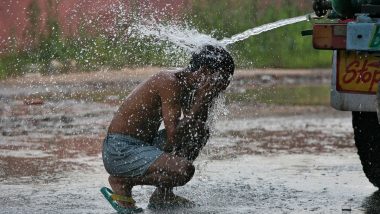New Delhi, April 30: Facing the brunt of an extended heat wave, Kalaikunda in West Bengal recorded a maximum temperature of 47.2 degrees Celsius, the highest ever in April anywhere in the country which reeled under searing heat and stifling humidity on Tuesday. The maximum of 47.2 degrees Celsius at Kalaikunda was 10.4 degrees above the normal for the season, an India Meteorological Department (IMD) official said, adding that it marked the prevalence of severe heat wave conditions over the Gangetic West Bengal region.
Popular hill stations such as Ugadhmandalam (Ooty) in Tamil Nadu and Matheran in Maharashtra also did not escape the brunt of the scorching summer with the mercury touching 29.4 degrees Celsius and 37 degrees Celsius, respectively. According to the department, 29.4 degrees Celsius was the highest ever maximum temperature recorded at Ooty in April, surpassing the 28.5 degrees Celsius recorded on April 29, 1986. Heatwave in Tamil Nadu: As Heat Wave Grips, Light to Moderate Rain Predicted in Thoothukudi, Tirunelveli and Kanniyakumari Districts
At Matheran, the only automobile-free hill station in the country, the mercury climbed to 37 degrees Celsius, the fourth highest maximum temperature recorded there ever. The hill station, located about 90 km from Mumbai, had recorded the highest ever maximum temperature of 38.5 degrees Celsius on February 6, 1979, followed by 37.4 degrees Celsius on April 2, 1975 and 37.2 degrees Celsius on April 7, 1978. Speaking of records, Churu in Rajasthan had clocked 49.9 degrees Celsius on May 26, 1998 and 49 degrees Celsius on June 5, 2003. Sikar, also in Rajasthan, had recorded a maximum of 49.7 degrees Celsius on June 12, 1993 and 49 degrees Celsius on May 26, 1994. Ajmer had recorded a maximum temperature of 47.4 degrees Celsius on May 19, 1997.
The automatic weather station at Baharagora in East Singhbhum district of Jharkhand recorded 47.1 degrees. However, long-term weather data was not available for the town to calculate the departure from normal temperatures for the season. Baripada in Odisha sizzled at 46.4 degrees Celsius, 8.9 degrees above the normal, followed by Balasore at 46 degrees Celsius (+10.1 degrees), Panagarh in West Bengal at 45.6 degrees Celsius (+10 degrees), Jamshedpur in Jharkhand at 45.5 degrees Celsius (+5.8 degrees) and Nandyal in Andhra Pradesh at 45 degrees Celsius (+4.2 degrees).
Several cities and towns in Odisha, West Bengal, Andhra Pradesh and Telangana recorded temperatures in excess of 44 degrees Celsius. Intensely hot conditions are expected in east India until May 1 and the south peninsular region over the next five days, the IMD said. The threshold for a heat wave is met when the maximum temperature of a weather station reaches at least 40 degrees Celsius in the plains, 37 degrees in the coastal areas, and 30 degrees in the hilly regions, and the departure from normal is at least 4.5 notches. A severe heat wave is declared if the departure from normal exceeds 6.4 notches. Heatwave in Tripura: Government Extends School Holidays for Three More Days as Heatwave Continues
The ongoing heat wave spell is the second this month. Heatwave conditions have been prevailing in Odisha since April 15 and in Gangetic West Bengal since April 17, according to the department. Amid the prevailing but weakening El Nino conditions, the IMD had earlier warned of extreme heat during the April-June period, coinciding with the seven-phase Lok Sabha elections. Lakhs of voters had to cope with the searing heat when they stepped out to exercise their franchise in the second phase of the Lok Sabha elections on April 26. Voting to elect representatives from 94 constituencies in 12 states will take place on May 7.
The weather office has said four to eight heat wave days are expected in different parts of the country in April against a normal of one to three days. Ten to 20 heatwave days are expected against a normal of four to eight in the entire April-June period. The areas and regions predicted to witness a higher number of heat wave days are Madhya Pradesh, Gujarat, Odisha, Andhra Pradesh, Madhya Maharashtra, Vidarbha, Marathwada, Bihar and Jharkhand. Some places may record more than 20 heatwave days. The intense heat could strain power grids and result in water shortages in parts of India.
Global weather agencies, including the IMD, are also expecting La Nina conditions to develop later in the year. El Nino conditions -- periodic warming of surface waters in the central Pacific Ocean -- are associated with weaker monsoon winds and drier conditions in India. La Nina conditions -- the antithesis of El Nino -- lead to plentiful rainfall during the monsoon season. In a mid-April update, the IMD said India would experience above-normal cumulative rainfall in the 2024 monsoon season with La Nina conditions, expected to set in by August-September, being the dominant factor.
The monsoon is critical for India's agricultural landscape, with 52 per cent of the net cultivated area dependent on it. It is also crucial for replenishing reservoirs critical for drinking water apart from power generation across the country.
(The above story is verified and authored by Press Trust of India (PTI) staff. PTI, India’s premier news agency, employs more than 400 journalists and 500 stringers to cover almost every district and small town in India.. The views appearing in the above post do not reflect the opinions of LatestLY)













 Quickly
Quickly


